| dc.contributor.advisor | Nikhil Agarwal and Michael D. Whinston. | en_US |
| dc.contributor.author | Popov, Anton. | en_US |
| dc.contributor.author | Atkin, David G., 1980- | en_US |
| dc.contributor.author | Chen, Keith. | en_US |
| dc.contributor.other | Massachusetts Institute of Technology. Department of Economics. | en_US |
| dc.date.accessioned | 2021-01-05T23:12:23Z | |
| dc.date.available | 2021-01-05T23:12:23Z | |
| dc.date.copyright | 2020 | en_US |
| dc.date.issued | 2020 | en_US |
| dc.identifier.uri | https://hdl.handle.net/1721.1/129003 | |
| dc.description | Thesis: Ph. D., Massachusetts Institute of Technology, Department of Economics, September, 2020 | en_US |
| dc.description | Cataloged from student-submitted PDF of thesis. "Chapter 3, written with professors David Atkin and Keith Chen"--Page 4. | en_US |
| dc.description | Includes bibliographical references (pages 169-173). | en_US |
| dc.description.abstract | First two chapters of this thesis study the wholesale and retail tier of the beer supermarket sales. In the first chapter, I am interested in consolidation of distributors in the beer industry and its interaction with the uniform pricing by retailers. I build a theoretical model which illustrates how distributor consolidation in a set of counties may affect retail prices in all counties, depending on how strong the incentive of retail chains to price uniformly is. I test the predictions of the model using Nielsen scanner price data. I study two events of distributor consolidation in Ohio in 2009-2011, which followed upstream MillerCoors joint venture in 2008. In one of the events, distributor consolidation has no price effects. In another, bigger event, prices of consolidated brands (Miller, Coors, Heineken and Modelo) in treated counties increase by 0.46% relative to the control ABI brands. I find no evidence of prices in other counties being affected. | en_US |
| dc.description.abstract | The findings are consistent with some cases of my theoretical model. The implications of this study are that modeling distribution tier and uniform pricing by retailers may be important for horizontal merger practitioners, both for retrospective analysis and for forecasting. Chapter 2 is devoted to the reasons for uniform pricing. I estimate the model, introduced in the first chapter, where supermarket chains have an incentive to set a uniform price for a given product across different locations. The model includes a product-specific baseline price which a supermarket chain sets, and a penalty for deviation from this baseline price. A single store will not deviate from the baseline price, if the marginal profits from doing so are smaller than the penalty parameter. My estimates suggest that the penalty for a dollar change from a benchmark price in a given week is around $12 to $16. Uniform pricing leads to suboptimal choice of prices relative to a problem with no penalty. | en_US |
| dc.description.abstract | There is substantial price re-optimization, which, however, does not affect profits much, due to changes in prices having a small first-order effect around the optimum. Supermarket chains only lose 0.4% of profits from pricing uniformly. Effects on consumers are highly heterogeneous across locations and weeks, with change in consumer surplus varying from -0.55$ to 1.92$ per consumer per week. I show that change in consumer surplus due to uniform prices is positively correlated with income, with higher income zip codes benefiting more from uniform pricing. This effect, although economically meaningful in aggregate, is not large for an average consumer. Chapter 3, written with professors David Atkin and Keith Chen, adds to the literature studying knowledge spillovers in modern cities. The returns to face-to-face interactions are of central importance to understanding the determinants of agglomeration. | en_US |
| dc.description.abstract | However, the existing literature studying patterns of geographic proximity in patent citations or industrial co-location has struggled to disentangle the benefits of face-to-face interactions from other spatial knowledge spillovers. In this paper we attempt to more directly measure face-to face interactions using highly granular worker geolocation data in Silicon Valley. To understand the degree to which knowledge flows result from their interactions, we study the relationship between cross-firm worker meetings and cross-citations between their firms. To navigate endogeneity concerns due to firms organizing meetings with firms they wish to learn from, we focus on serendipitous meetings--measured by the interactions of workers in neighboring firms in very different industries--that play a central role in the urban theories of Jane Jacobs. | en_US |
| dc.description.abstract | The subset of these chance meetings occurring during work-hours also serve as costs shifters to meeting face-to-face rather than remotely, allowing us to separately identify the returns to planned meetings. Our results suggest substantial knowledge spillovers from face-to-face interactions, including increases in citations resulting from serendipitous meetings that are a third as large as the elasticity with respect to physical distance. | en_US |
| dc.description.statementofresponsibility | by Anton Popov. | en_US |
| dc.format.extent | 173 pages | en_US |
| dc.language.iso | eng | en_US |
| dc.publisher | Massachusetts Institute of Technology | en_US |
| dc.rights | MIT theses may be protected by copyright. Please reuse MIT thesis content according to the MIT Libraries Permissions Policy, which is available through the URL provided. | en_US |
| dc.rights.uri | http://dspace.mit.edu/handle/1721.1/7582 | en_US |
| dc.subject | Economics. | en_US |
| dc.title | Essays in industrial organization and urban economics | en_US |
| dc.type | Thesis | en_US |
| dc.description.degree | Ph. D. | en_US |
| dc.contributor.department | Massachusetts Institute of Technology. Department of Economics | en_US |
| dc.identifier.oclc | 1227094706 | en_US |
| dc.description.collection | Ph.D. Massachusetts Institute of Technology, Department of Economics | en_US |
| dspace.imported | 2021-01-05T23:12:21Z | en_US |
| mit.thesis.degree | Doctoral | en_US |
| mit.thesis.department | Econ | en_US |
